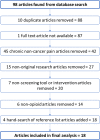A systematic review of assessment approaches to predict opioid misuse in people with cancer
- PMID: 35166898
- PMCID: PMC9135805
- DOI: 10.1007/s00520-022-06895-w
A systematic review of assessment approaches to predict opioid misuse in people with cancer
Abstract
Context: Cancer prevalence is increasing, with many patients requiring opioid analgesia. Clinicians need to ensure patients receive adequate pain relief. However, opioid misuse is widespread, and cancer patients are at risk.
Objectives: This study aims (1) to identify screening approaches that have been used to assess and monitor risk of opioid misuse in patients with cancer; (2) to compare the prevalence of risk estimated by each of these screening approaches; and (3) to compare risk factors among demographic and clinical variables associated with a positive screen on each of the approaches.
Methods: Medline, Cochrane Controlled Trial Register, PubMed, PsycINFO, and Embase databases were searched for articles reporting opioid misuse screening in cancer patients, along with handsearching the reference list of included articles. Bias was assessed using tools from the Joanna Briggs Suite.
Results: Eighteen studies met the eligibility criteria, evaluating seven approaches: Urine Drug Test (UDT) (n = 8); the Screener and Opioid Assessment for Patients with Pain (SOAPP) and two variants, Revised and Short Form (n = 6); the Cut-down, Annoyed, Guilty, Eye-opener (CAGE) tool and one variant, Adapted to Include Drugs (n = 6); the Opioid Risk Tool (ORT) (n = 4); Prescription Monitoring Program (PMP) (n = 3); the Screen for Opioid-Associated Aberrant Behavior Risk (SOABR) (n = 1); and structured/specialist interviews (n = 1). Eight studies compared two or more approaches. The rates of risk of opioid misuse in the studied populations ranged from 6 to 65%, acknowledging that estimates are likely to have varied partly because of how specific to opioids the screening approaches were and whether a single or multi-step approach was used. UDT prompted by an intervention or observation of aberrant opioid behaviors (AOB) were conclusive of actual opioid misuse found to be 6.5-24%. Younger age, found in 8/10 studies; personal or family history of anxiety or other mental ill health, found in 6/8 studies; and history of illicit drug use, found in 4/6 studies, showed an increased risk of misuse.
Conclusions: Younger age, personal or familial mental health history, and history of illicit drug use consistently showed an increased risk of opioid misuse. Clinical suspicion of opioid misuse may be raised by data from PMP or any of the standardized list of AOBs. Clinicians may use SOAPP-R, CAGE-AID, or ORT to screen for increased risk and may use UDT to confirm suspicion of opioid misuse or monitor adherence. More research into this important area is required.
Significance of results: This systematic review summarized the literature on the use of opioid misuse risk approaches in people with cancer. The rates of reported risk range from 6 to 65%; however, true rate may be closer to 6.5-24%. Younger age, personal or familial mental health history, and history of illicit drug use consistently showed an increased risk of opioid misuse. Clinicians may choose from several approaches. Limited data are available on feasibility and patient experience. PROSPERO registration number. CRD42020163385.
Keywords: Cancer; Drug misuse; Opioid; Pain; Screening.
© 2022. The Author(s).
Figures
Similar articles
-
Cost-effectiveness of using prognostic information to select women with breast cancer for adjuvant systemic therapy.Health Technol Assess. 2006 Sep;10(34):iii-iv, ix-xi, 1-204. doi: 10.3310/hta10340. Health Technol Assess. 2006. PMID: 16959170
-
Eliciting adverse effects data from participants in clinical trials.Cochrane Database Syst Rev. 2018 Jan 16;1(1):MR000039. doi: 10.1002/14651858.MR000039.pub2. Cochrane Database Syst Rev. 2018. PMID: 29372930 Free PMC article.
-
Oxycodone for cancer-related pain.Cochrane Database Syst Rev. 2022 Jun 9;6(6):CD003870. doi: 10.1002/14651858.CD003870.pub7. Cochrane Database Syst Rev. 2022. PMID: 35679121 Free PMC article.
-
A rapid and systematic review of the clinical effectiveness and cost-effectiveness of paclitaxel, docetaxel, gemcitabine and vinorelbine in non-small-cell lung cancer.Health Technol Assess. 2001;5(32):1-195. doi: 10.3310/hta5320. Health Technol Assess. 2001. PMID: 12065068
-
Intravenous versus inhalational maintenance of anaesthesia for postoperative cognitive outcomes in elderly people undergoing non-cardiac surgery.Cochrane Database Syst Rev. 2018 Aug 21;8(8):CD012317. doi: 10.1002/14651858.CD012317.pub2. Cochrane Database Syst Rev. 2018. PMID: 30129968 Free PMC article.
Cited by
-
Influencing factors of ocular pain in dry eye disease patients at high altitude.Int J Ophthalmol. 2024 Dec 18;17(12):2214-2220. doi: 10.18240/ijo.2024.12.08. eCollection 2024. Int J Ophthalmol. 2024. PMID: 39697888 Free PMC article.
-
Adherence to Opioid Patient Prescriber Agreements at a Safety Net Hospital.Cancers (Basel). 2023 May 27;15(11):2943. doi: 10.3390/cancers15112943. Cancers (Basel). 2023. PMID: 37296905 Free PMC article.
-
Identifying provider, patient and practice factors that shape long-term opioid prescribing for cancer pain: a qualitative study of American and Australian providers.BMJ Open. 2024 Mar 21;14(3):e082033. doi: 10.1136/bmjopen-2023-082033. BMJ Open. 2024. PMID: 38514141 Free PMC article.
-
Causal Effects and Immune Cell Mediators of Prescription Analgesic Use and Risk of Liver Cancer and Precancerosis in European Population: A Mendelian Randomization Study.Biomedicines. 2024 Jul 11;12(7):1537. doi: 10.3390/biomedicines12071537. Biomedicines. 2024. PMID: 39062110 Free PMC article.
References
-
- International Agency for Research on Cancer- World Health Organisation. Global Cancer Observatory,. 2018 [cited 2020 4th November,]
-
- Australian Institute of Health and Welfare, Cancer in Australia: In brief 2019. Cancer series no. 122. , A.I.o.H. Wellbeing, Editor. 2019: Canberra.
-
- National Institute on Drug Abuse. Misuse of prescription drugs report overview. 2021 [cited 2021 9th March,]; Available from: https://www.drugabuse.gov/publications/research-reports/misuse-prescript... on 2021
Publication types
MeSH terms
Substances
LinkOut - more resources
Full Text Sources
Medical
Research Materials
Miscellaneous


